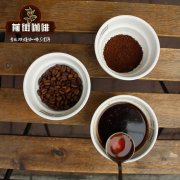What are the flavors and characteristics of the eight regions of Guatemala? What are the grades?
What are the flavors and characteristics of the eight major producing areas in Guatemala? What are the grades?

In 1750, Father Jesuit introduced coffee coffee to Guatemala, where the coffee industry was developed by German colonists at the end of the 19th century. Today, most of the coffee industry's production takes place in the south of the country.
Coffee producing areas in Guatemala:
The slopes of the SierraMadre volcano provide ideal conditions for growing high-quality coffee beans, and coffee grows at high elevations. This kind of coffee has a mixed flavor and a spicy flavor. The extra hard coffee beans here are good coffee to be seen at first sight. They are full of grains, delicious and well-balanced in acidity.
Antigua is also a famous producer of coffee. Antigua coffee is produced in HaciendaCarmona, and the best coffee to taste is ELPulcal, which is not good in quantity and tastes more mellow, richer and more tobacco-like than other Guatemalan coffees. Every 30 years or so, the area near Antigua is hit by a volcanic outbreak, which provides more nitrogen to the already rich land, and sufficient rainfall and light make the area more suitable for growing coffee.
Other coffee producers include SanMarco, Oriente&Coban, Palcya, Mataquescuintia and LaUman in zacapa. The establishment of the Special Coffee Association means that the Guatemalan government has begun to pay attention to high-quality coffee, and its efforts will soon bear fruit.
The main areas in Guatemala that are rich in romaine coffee are LakeAtitlan and Huehuentenango.
In addition, Guatemala has attracted a lot of attention because of its giant coffee beans.
The characteristics of Guatemalan coffee:
Compared with other kinds of coffee, tasters prefer this kind of mixed coffee, which is born at high altitude and has a spicy flavor. The extra hard coffee beans here are good coffee to be seen at first sight. They are full of grains, delicious and well-balanced in acidity.
Taste: it is full of grains, and the taste is melancholy and depressing.
Recommended baking method: medium or deep baking
★★★: Jiejia
The market for Guatemalan coffee:
Guatemalan coffee exports are easily controlled by private companies, but the National Coffee Commission (AsociacionNacionaldeCafe) controls other departments of the coffee industry. At present, some of Guatemala's most expensive coffee is exported to Japan.
Most small-scale producers are descendants of the Mayan, who like to be called natives. At present, he is also benefiting from a US-funded project, known as "TheProject", which encourages the development of small, high-quality coffee growers.
Ekataru Valley
Uplifted to 2000 meters (6500 feet), dense and ecological, the nearby Fuego volcano erupted, making its coarse, sandy soil rich in all kinds of minerals. Warm seafood from the Pacific and distinct seasons allow coffee in this region to be dried by daylight and processed in a family-style traditional method that has been tiring for years.
[characteristics] the acidity is clear, the fragrance is dry and pleasant, the mellow thickness is good, and the acidity is clear and long.
Koban of Rainforest
It is rainy and rainy all the year round. Most of the Koban coffee in the rainforest is grown in the undulating and hilly mountains of the western region, and is deeply influenced by limestone and clay in the Atlantic basin. Koban has two seasons: rainy season and rainy season.
[features] clear and fruity taste, balanced mellow thickness, pleasant fragrance.
Antigua
Rich volcanic soil, low temperature, plenty of light, and cool night are the characteristics of this producing area. The valley is surrounded by three volcanoes: Agua, Fuego and Acatenango. The plague of volcanic ash makes the soil of Antigua rich in minerals. Volcanic pumice can maintain humidity and overcome the deficiency of low rainfall in Antigua; dense pumice can prevent frost damage.
[special] the fragrance is rich, the balance is good, the sweetness is high, and the taste is elegant.
Tiny Nanguo Highland
Of the three major non-volcanic coffee producing areas in Guatemala, the Weitango Highlands are the driest and highest areas of weather. they come from the dry weather of Mexico's Tehuantepec plateau to protect the coffee from frost, and coffee can be grown to a depth of 2000 meters (6500 feet). Due to the poor location, all coffee bars have to process their own coffee. Fortunately, there are so many streams in the area that they can almost set up small processing stations.
[features] the taste is balanced and pleasant, with high mellow thickness and "wine" taste.
Farahan Plateau
The area is volcanic soil, with high altitude, sufficient rainfall and high degree. Ash from Pacaya, Guatemala's most active volcano, provides important minerals for the soil of the region. There is plenty of light in the dry season, despite the heavy rain and dew in the morning, but it dissipates quickly. As a result, 100% of the coffee in the area is processed all day.
[characteristics] the acidity is bright and consistent, the fragrance is sufficient, and the alcohol is thick.
Xinyi Fang
The New Zealand area is the newest of the major coffee producing areas in Guatemala. In ancient times, it was a volcanic area, and the soil here was made up of pegmatite, so it contained rich minerals. The New Zealand area was once the most popular area in Guatemala before it began to grow coffee. since the 1950s, the people in the mountains have started growing coffee on the natural and abundant land here. Slowly, the area is thriving one by one, and now it has become a rising star in the Guatemalan coffee growing industry.
[features] the palate is well-balanced, mellow in thickness and chocolate in taste.
Traditional Artitesian
Attica is one of the five largest volcanic coffee producing areas in Guatemala, and its soil is the richest among the five volcanic coffee producing areas. 90% of the traditional Atit coffee is grown on the slopes of the violent volcanoes on the shores of Lake Attica, and the daily micro-movement of the lake water is an important factor affecting the microclimate environment in the region. The farming area has been tired of excellent planting and processing techniques for a long time.
Atit Lake is a large lake with a depth of about 1000 feet and an area of 140 square miles, which was formed more than 80000 years ago. Is the emblem planted in the morning? Braving the ⒌ dimple of the lake, it began to show a beautiful posture of pale color. The night break and the afternoon lunch known as Xocomil are the special weather around the Atit Lake.
[features] the fragrance is refreshing, the acidity is bright and the alcohol is thick.
Mengke volcano
It is the most weathered of Guatemala's eight coffee-producing regions, with up to 200in (5000 mm) of rainfall. The rainy season is earlier than in other areas, and coffee bars blossom earlier. Like other tropical areas in Guatemala, volcanic coffee is grown and processed by small hogs. Because of the heavy rainfall in the rainy season, most coffee is dried by light exposure and then dried by a Guardiola dryer.
[features] the fragrance and taste have a slight floral aroma, clear acidity and good mellow thickness.
Important Notice :
前街咖啡 FrontStreet Coffee has moved to new addredd:
FrontStreet Coffee Address: 315,Donghua East Road,GuangZhou
Tel:020 38364473
- Prev

Characteristics of coffee at Incht Manor, Guatemala? What are the characteristics of the flavor trend?
Characteristics of coffee at Incht Manor, Guatemala? What are the characteristics of the flavor trend? Incht Manor has a long history of coffee ecological park. In 2008, it continued to win six times the world's highest quality C.O.E international coffee cup test in the name of local fruit. Since 1900, the estate began to grow coffee, which is run by the Aguirre family. Occupy the pristine rainforest environment at the ideal high altitude,
- Next

The history and culture of coffee cultivation in Guatemala? The cultivation of coffee beans in dangerous countries?
The history and culture of coffee cultivation in Guatemala? What are the producing areas? The cultivation and spread of coffee beans in Guatemala? The Republic of Guatemala (Spain: Repblica de Guatemala) is a country of Central America, located in the southern part of North America, bordering Mexico to the north, Celis to the north, Honduras and Peru to the south. At the same time in Guatemala City, the capital
Related
- Detailed explanation of Jadeite planting Land in Panamanian Jadeite Manor introduction to the grading system of Jadeite competitive bidding, Red bid, Green bid and Rose Summer
- Story of Coffee planting in Brenka region of Costa Rica Stonehenge Manor anaerobic heavy honey treatment of flavor mouth
- What's on the barrel of Blue Mountain Coffee beans?
- Can American coffee also pull flowers? How to use hot American style to pull out a good-looking pattern?
- Can you make a cold extract with coffee beans? What is the right proportion for cold-extracted coffee formula?
- Indonesian PWN Gold Mandrine Coffee Origin Features Flavor How to Chong? Mandolin coffee is American.
- A brief introduction to the flavor characteristics of Brazilian yellow bourbon coffee beans
- What is the effect of different water quality on the flavor of cold-extracted coffee? What kind of water is best for brewing coffee?
- Why do you think of Rose Summer whenever you mention Panamanian coffee?
- Introduction to the characteristics of authentic blue mountain coffee bean producing areas? What is the CIB Coffee Authority in Jamaica?

